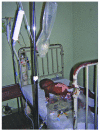Peritoneal dialysis in childhood acute kidney injury: experience in southwest Nigeria
- PMID: 22550119
- PMCID: PMC3525432
- DOI: 10.3747/pdi.2011.00275
Peritoneal dialysis in childhood acute kidney injury: experience in southwest Nigeria
Abstract
Background: The choices for renal replacement therapy (RRT) in childhood acute kidney injury (AKI) are limited in low-resource settings. Peritoneal dialysis (PD) appears to be the most practical modality for RRT in young children with AKI in such settings. Data from sub-Saharan Africa on the use of PD in childhood AKI are few.
Methods: We performed a retrospective study of children who underwent PD for AKI at a tertiary-care hospital in southwest Nigeria from February 2004 to March 2011 (85 months).
Results: The study included 27 children (55.6% female). Mean age was 3.1 ± 2.6 years, with the youngest being 7 days, and the oldest, 9 years. The causes of AKI were intravascular hemolysis (n = 11), septicemia (n = 8), acute glomerulonephritis (n = 3), gastroenteritis (n = 3), and hemolytic uremic syndrome (n = 2). Peritoneal dialysis was performed manually using percutaneous or adapted catheters. Duration of PD ranged from 6 hours to 12 days (mean: 5.0 ± 3.3 days). The main complications were peritonitis (n = 10), pericatheter leakage (n = 9), and catheter outflow obstruction (n = 5). Of the 27 patients, 19 (70%) survived till discharge.
Conclusions: In low-resource settings, PD can be successfully performed for the management of childhood AKI. In our hospital, the use of adapted catheters may have contributed to the high complication rates. Peritoneal dialysis should be promoted for the management of childhood AKI in low-resource settings, and access to percutaneous or Tenckhoff catheters, dialysis fluid, and automated PD should be increased.
Figures
References
-
- Olowu WA. Renal failure in Nigerian children: factors limiting access to dialysis. Pediatr Nephrol 2003; 18:1249–54 - PubMed
-
- Olowu WA, Adelusola KA. Pediatric acute renal failure in southwestern Nigeria. Kidney Int 2004; 66:1541–8 - PubMed
-
- Symons JM, Chua AN, Somers MJ, Baum MA, Bunchman TE, Benfield MR, et al. Demographic characteristics of pediatric continuous renal replacement therapy: a report of the prospective pediatric continuous renal replacement therapy registry. Clin J am Soc Nephrol 2007; 2:732–8 - PubMed
MeSH terms
LinkOut - more resources
Full Text Sources




